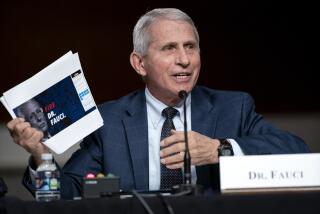The AIDS Chronicles : Randy Shilts Writes the Biography of an Epidemic and Finds More Bunglers Than Heroes
- Share via
SAN FRANCISCO — As he merged into the milling throng at the Castro Street fair in San Francisco last Sunday, Randy Shilts figured his chances were equally good of getting slugged or hugged.
An openly gay reporter whose beat includes the most openly gay community in America, Shilts is used to being embroiled in the raucous fray of San Francisco politics. Last weekend, though, he thought that his presence might be particularly volatile.
First Copies at Bookstore
On Friday, the first copies of his epic exploration of the AIDS epidemic, “And the Band Played On: Politics, People and the AIDS Epidemic,” arrived at The Love that Dares bookstore, and by Saturday afternoon, men could be seen at Castro Street’s wood-paneled cafes with the 630-page, $25 volume propped up beside cups of cappuccino.
Earlier, Shilts had dropped by the offices of the Chronicle, where he has spent five years reporting on AIDS. He found an electronic message from a colleague on his computer screen: “ . . . not only are you going to be a (expletive) multimillionaire, but yer going to cop a Pulitzer too.” Early reviews have praised the book for its no-holds-barred reporting (“ . . . A landmark work. Its importance cannot be overstated,” said Publishers Weekly) and producers are already bidding for film rights.
But the myriad individuals and institutions mentioned in the book are not reacting with universal enthusiasm. No less an authority than National Cancer Institute retrovirologist Robert Gallo has raised strong objections to certain aspects of the book and claims that significant corrections will appear in future editions.
Shilts himself complains that headline writers at certain newspapers and magazines have blown out of proportion a controversial segment of the story--his painstaking investigation of “Patient Zero,” the French Canadian airline flight attendant who medical detectives connected sexually with 40 of the first 240 AIDS victims in this country, and who may have brought AIDS to the United States.
As Shilts portrays the unfolding of the epidemic--naming names all the way--the institutions Americans count on to protect them from tragedy failed miserably. As fatalities rise in his chronological account, the public health establishment dawdles. The international research community bickers over petty issues, the media smugly pigeonholes the disease as a niggling problem of an unimportant fringe group and politicians let self-interest outweigh public health issues while the Reagan Administration repeatedly performs radical surgery on an already emaciated AIDS budget.
Shilts also turns up the lights on the homosexual community itself, revealing the wildly indulgent lives of many who, in his depiction, denied the reality of AIDS and let their commercial, sexual and public relations interests impede their personal and professional decisions about confronting the disease.
Past reporting of this sort by Shilts had already stirred some gays to outrage, he said. A homosexual newspaper labeled him a “Gay Uncle Tom.” But as Shilts strolled through the fair on this “gay high holy day,” male couples stepped forward to congratulate him, shake his hand and even offer hugs. Clearly, times have changed, he observed.
“And the Band Played On” unfolds chronologically, intercutting narrative scenes from the lives of scientists, physicians, politicians, activists and victims as they’re drawn into the wake of a mysterious new disease.
“Pure Michener,” Shilts calls his technique. But the book reads more like an amalgam of detective novel, political potboiler and--with its quickly rising body count--horror story.
There are few pure heroes or villains in the yarn, but rather real-life characters whose good intentions lead to indecisive bumbling, characters who let greed or the lust for glory overcome altruism, and people who simply lack the leadership to plunge into a battle that is dangerous in so many ways.
On the other hand, there are many characters who have the epidemic thrust upon them and react with a resolve and courage that, in retrospect, might be defined as heroism.
Shilts himself appears rarely, and then only as “a reporter,” but his own story and persona are interesting if not integral to the tale.
A native of Aurora, Ill., Shilts was a journalism student at the University of Oregon when he decided it would be inappropriate to conceal his sexual orientation.
‘Personal Integrity’
“To me, being open about being gay is solely a statement of personal integrity,” he said. “I’d met a lot of older gay professionals who lived their lives in terror that they were going to be discovered. I decided I was never going to be in a position in my life where I had to cover up who I was.”
Although he never hid his homosexuality, he doesn’t make an issue of it either--which has led to some interesting situations. Shilts recalls reporting on a speech by state Senator John Briggs (R-Fullerton), author of the 1978 ballot proposition which would have banned gay teachers from California classrooms.
“On my way in, he was very friendly,” Shilts said of Briggs. “He said, ‘Watch out when you go in there, there’s homosexuals in there.’ ”
“I said, how can you tell?”
Briggs replied: “Ah, you can tell by looking at them . . . by the whites of their eyes.” “My cameraman was in hysterics,” Shilts said.
First Book Wins Job
Shilts worked for gay newspapers and as a free-lance television reporter, but his homosexuality kept him from finding full-time work, he said. But when his first book, “The Mayor of Castro Street: The Life and Times of Harvey Milk,” received critical acclaim, the Chronicle offered him a job.
As a Chronicle reporter, Shilts first covered several beats, the homosexual community among them. Those were the glory days of the gay revolution that had swept through San Francisco in the ‘70s. But by the early ‘80s, word of a new “gay cancer” was becoming a topic of nervous discussion. In May of 1982, Shilts wrote his first piece on the still mysterious illness. Later he became the first reporter in the country to be assigned to AIDS full time.
“I never had any training as a health writer, but I always did well in biology,” Shilts said. “The human body is a fairly simple and an extremely logical organism to understand--unlike the body politic.”
But Shilts soon perceived that the two subjects were inextricable and began filing requests under the Freedom of Information Act to get internal documents from the Center for Disease Control, the National Institutes of Health and other agencies. At the same time, disgruntled researchers and officials began slipping Shilts information. What he discovered was that “the federal health bureaucracy was ignoring its own health experts and not giving adequate attention to AIDS,” Shilts said.
To the amazement of the Chronicle staff, much of the major media ignored their exposes, Shilts said.
‘Sob-Sister Reporting’
“I’m not God’s gift to journalism. The people who gave me memos would have done anything to get them into the papers,” he said. But “investigative reporters who were real men didn’t want to cover AIDS-related anything. It was trivial. . . . There was lots of sob sister reporting. There was great, eloquent science reporting. But nobody was doing behind-the-scenes political stuff.”
Shilts, on the other hand, was motivated in ways most reporters weren’t. By 1983, a young therapist named Gary Walsh became his first close friend to contract the disease, and as the epidemic spread, many more succumbed.
“I wasn’t just an author doing a story. I live in the gay community and AIDS is a part of my life. The people who have died because of institutional neglect aren’t just ‘those people out there.’ They’re people I care about.”
“And the Band Played On” traces neglect of the AIDS problem to the highest levels. Of Ronald Reagan, Shilts writes: “Already some said (he) would be remembered in history books for one thing beyond all else: He was the man who had let AIDS rage through America, the leader of the government that when challenged to action had placed politics above the health of the American people.”
Requesting Corrections
With a few distinct exceptions, the scientific community doesn’t fare much better in Shilts’ portrayal. Researchers at the Center for Disease Control--many of whom figure among the book’s heroes--were unwilling to comment on Shilts’ portrayal. However, Robert Gallo, at the National Cancer Institute, said Wednesday that he had just talked to Shilts, told him that various aspects of the book were simply wrong, and that Shilts had agreed to make numerous changes.
“He told me he would correct every single thing that I told him about. . . . (But) the damage is done.” Such attacks, Gallo said, make “you lose your ability to focus, you don’t feel like working on the problem any longer. . . . I shouldn’t let these things bother me, but they do. . . . They bother me a lot.”
Speaking from New York, where he’d just arrived for an appearance on “Good Morning America,” Shilts acknowledged that he has agreed to correct “about a dozen sentences” in the book as a result of his conversation with Gallo. “And he’s sending me some documentation, and that may add more (corrections).
“We had a real constructive talk that lasted for an hour,” Shilts continued. He denies, however, that the overall portrait of Gallo and the interagency struggles are inaccurate.
Atmosphere of Competition
‘I believe I present him as a brilliant and complicated individual. . . . I think Bob would admit that there was this atmosphere of competition. He doesn’t believe it hampered science. But an awful lot of people do. . . . To me the problem at NCI is not Bob Gallo, but that there’s a real systemic problem there, and the conflict between the NCI and the CDC should not have been tolerated.”
Shilts also sees as intolerable the conflicts that occurred among health professionals at local levels.
Shilts knew firsthand about the unfettered sexuality that was once in vogue within the gay community--that there were “commercial sex emporiums” where men might have as many as 10 partners a night. And “as soon as you had the blood transfusion cases (in 1983), it was obvious that this was an infectious disease. If you put one and one together,” Shilts said, “you saw that the potential was there for an apocalypse.”
San Francisco moved much more quickly than New York or Los Angeles in educating the gay community, Shilts writes. Yet even San Francisco was sufficiently sluggish in taking the necessary steps so that thousands of people may have been infected needlessly, he believes.
Besides being lucrative, bathhouses were symbols of the liberation homosexuals had fought so hard to achieve, so when Shilts’ articles quoted health officials and gay activists who saw them as breeding grounds for disease, an uproar ensued.
“The gay community didn’t want me to write about things like bathhouses that made gays look bad. But to me that was like going to one side of a burning building and covering the firemen trying to put out the fire, and then ignoring the guy on the other side who’s dumping gas on it.”
San Francisco Official
In the middle of the conflict was Mervyn Silverman, director of the San Francisco Department of Public Health, whom Shilts portrays as a well-intended professional who let the virus run rampant because he was afraid to raise the wrath of homosexuals.
Contacted in San Francisco, where he is now president of the American Foundation for AIDS Research, Silverman said he had read most of the 45 or so references to him in the book.
“I think (Shilts’) reading of me is incorrect,” he said. “He had an agenda. . . .
“When you’re trying to get a behavior change, you have to do it less with a frontal assault and more by working with the community. That may seem like playing politics . . . but there was no need. . . . I wasn’t appointed or elected by the community nor would I be unappointed or unelected by them.”
Shilts still catches glimpses of his neighbor Silverman as the two jog each morning, and he thinks that’s good. “When you’re writing about someone critically, you should have to face them every now and then.”
Patient Zero
The one person Shilts will never have to face is also the person who has, so far, stirred the most media interest in the book: Patient Zero.
Shilts first heard about Patient Zero in 1982, when he learned that San Francisco public health official Selma Dritz had written to the attorney general to see if there were any legal way to stop a known AIDS carrier who was frequenting the Castro Street baths.
About the same time, Shilts read a Center for Disease Control report about a “cluster study” which traced known cases of the still mysterious disease through the sexual liaisons of an unidentified “Patient Zero.”
Both Dritz and the CDC were vehement in refusing to name the person in question. But through his own sources, Shilts learned that in both cases the mystery person was a French-Canadian steward for Air Canada. He realized that they were the same person.
“You couldn’t tell from reading the cluster study that he may have been the person who brought (the AIDS virus) into the United States,” Shilts said. But soon thereafter he interviewed a New York City public health official who mentioned that the first two patients in that city with AIDS symptoms--perhaps the first two people in the United States--both mentioned a French-Canadian flight attendant for Air Canada as a past sexual partner or the partner of one of their past lovers.
Popping Up Everywhere
Eventually Shilts turned up the name of the man he was tracking: Gaetan Dugas. “I decided to start asking everyone I interviewed to tell me about Gaetan. . . . The name popped up everywhere.”
At a journalism conference in Canada, he happened to meet friends of the Air Canada flight attendant. They had albums filled with his pictures and a wealth of information on the young blond jet-setter who “would walk into a gay bar, scan the crowd and announce to his friends, ‘I am the prettiest one.’ ”
As it turned out, Shilts’ investigation also led him to the real detective work of William Darrow, a epidemiologist with the CDC who had followed sexual contacts of early AIDS patients back to Patient Zero.
Shilts has never claimed that Dugas, who died on March 30, 1984, is the man who brought AIDS to the United States. But Darrow and other epidemiologists have confirmed that Dugas is a prime suspect.
For Shilts, the importance of Patient Zero as a symbol of the terror AIDS would inflict came during an interview with Wall Street businessman Paul Popham, who was dying of AIDS. Shilts asked Popham if he’d heard of this flight attendant named Gaetan.
‘Horrible Moments’
“Paul said, yes, his old boyfriend, Jack, had picked Gaetan up in 1980. . . . It was one of the most horrible moments of all the horrible moments in doing this story. Paul was emaciated and had lesions all over him. I realized I was looking at somebody who was effectively dying of the virus, and that it was courtesy of Gaetan. . . . That was when the entire scope of the AIDS tragedy just hit me like a bullet between the eyes. Gaetan had slept with somebody on Oct. 31 of 1980 and now I was looking at somebody in 1986 who was dying.”
As he walked through the contained chaos of the Castro Street fair, Shilts pointed out how different the scene was from fairs back in the early days of the gay revolution.
Here and there fetishists lolled about in chains and black leather. A smattering of drag queens sashayed about making lewd offers. For the most part, though, the festival was pleasant but subdued--a big yuppie party where men held hands with men. The community had finally rallied against the insidious terrorist in its midst. AIDS posters had replaced bathhouse ads. Health was the big thing now.
But the battle is hardly over, Shilts said. All the gaunt, death-mask faces in the crowd made that clear.
More to Read
Sign up for our Book Club newsletter
Get the latest news, events and more from the Los Angeles Times Book Club, and help us get L.A. reading and talking.
You may occasionally receive promotional content from the Los Angeles Times.







